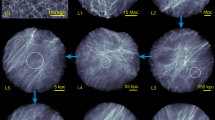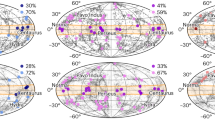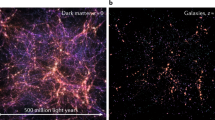Abstract
Ordinary baryonic particles (such as protons and neutrons) account for only one-sixth of the total matter in the Universe1,2,3. The remainder is a mysterious ‘dark matter’ component, which does not interact via electromagnetism and thus neither emits nor reflects light. As dark matter cannot be seen directly using traditional observations, very little is currently known about its properties. It does interact via gravity, and is most effectively probed through gravitational lensing: the deflection of light from distant galaxies by the gravitational attraction of foreground mass concentrations4,5. This is a purely geometrical effect that is free of astrophysical assumptions and sensitive to all matter—whether baryonic or dark6,7. Here we show high-fidelity maps of the large-scale distribution of dark matter, resolved in both angle and depth. We find a loose network of filaments, growing over time, which intersect in massive structures at the locations of clusters of galaxies. Our results are consistent with predictions of gravitationally induced structure formation8,9, in which the initial, smooth distribution of dark matter collapses into filaments then into clusters, forming a gravitational scaffold into which gas can accumulate, and stars can be built10.
This is a preview of subscription content, access via your institution
Access options
Subscribe to this journal
Receive 51 print issues and online access
$199.00 per year
only $3.90 per issue
Buy this article
- Purchase on Springer Link
- Instant access to full article PDF
Prices may be subject to local taxes which are calculated during checkout





Similar content being viewed by others
References
Zwicky, F. Die Rotverschiebung von extragalaktischen Nebeln. Helv. Phys. Acta 6, 110–127 (1933)
Bergstrom, L. Nonbaryonic dark matter: observational evidence and detection methods. Rep. Prog. Phys. 63, 793–841 (2003)
Clowe, D. et al. A direct empirical proof of the existence of dark matter. Astrophys. J. 648, L109–L113 (2006)
Blandford, R., Saust, A., Brainerd, T. & Villumsen, J. The distortion of distant galaxies by large-scale structure. Mon. Not. R. Astron. Soc. 251, 600–627 (1991)
Kaiser, N. Weak gravitational lensing of distant galaxies. Mon. Not. R. Astron. Soc. 388, 272–286 (1992)
Bartelmann, M. & Schneider, P. Weak gravitational lensing. Phys. Rep. 340, 291–472 (2001)
Refregier, A. Weak gravitational lensing by large-scale structure. Annu. Rev. Astron. Astrophys. 41, 645–668 (2004)
Davis, M., Efstathiou, G., Frenk, C. & White, S. The evolution of large-scale structure in a universe dominated by cold dark matter. Astrophys. J. 292, 371–394 (1985)
Springel, V. et al. Simulating the joint evolution of quasars, galaxies and their large-scale distribution. Nature 435, 629–636 (2005)
Dekel, A. & Lahav, O. Stochastic nonlinear galaxy biasing. Astrophys. J. 520, 24–34 (1999)
Scoville, N. et al. COSMOS: Hubble Space Telescope observations. Astrophys. J. (in the press).
Leauthaud, A. et al. COSMOS: ACS galaxy catalog. Astrophys. J. (submitted).
Schneider, P., van Waerbeke, L. & Mellier, Y. B-modes in cosmic shear from source redshift clustering. Astron. Astrophys. 389, 729–741 (2002)
Hasinger, G. et al. The XMM-Newton wide-field survey in the COSMOS field: I. Survey description. Astrophys. J. (in the press).
Guzzo, G. et al. A large-scale stucture at z=0.73 and the relation of galaxy morphologies to local environment. Astrophys. J. (submitted).
Shen, J., Abel, T., Mo, H. & Sheth, R. An excursion set model of the cosmic web: the abundance of sheets, filaments, and halos. Astrophys. J. 645, 783–791 (2006)
Massey, R. et al. Weak lensing from space: II. Dark matter mapping. Astron. J. 127, 3089–3101 (2004)
Bacon, D. & Taylor, A. Mapping the 3D dark matter potential with weak shear. Mon. Not. R. Astron. Soc. 344, 1307–1326 (2003)
Taylor, A. et al. Mapping the 3D dark matter with weak lensing in COMBO-17. Mon. Not. R. Astron. Soc. 353, 1176–1196 (2003)
Saunders, W. et al. Density and velocity fields from the PSCz survey. In Towards an Understanding of Cosmic Flows (eds Courteau S., Strauss M. & Willick, J) ASP Conf. Ser. 201, 228–236 (Astronomical Society of the Pacific, San Francisco, 1999)
Rhodes, J., Refregier, A. & Groth, E. Weak lensing measurements: a revisited method and application to Hubble Space Telescope images. Astrophys. J. 536, 79–100 (2000)
Kaiser, N. & Squires, G. Mapping the dark matter with weak gravitational lensing. Astrophys. J. 404, 441–450 (1993)
Starck, J.-L. & Murtagh, F. Astronomical Image and Data Analysis 2nd edition (Springer, Heidelberg, 2006)
Starck, J.-L., Pires, S. & Refregier, A. Weak lensing mass reconstruction using wavelets. Astron. Astrophys. 451, 1139–1150 (2006)
Hopkinson, G., Dale, C. & Marshall, P. Proton effects in charge-coupled devices. IEEE Trans. Nucl. Sci. 43, 614–627 (1996)
Rhodes, J. et al. Removing the effects of the Advanced Camera for Surveys point spread function. Astrophys. J. (submitted).
Capak, P. et al. Photometric redshifts of galaxies in COSMOS. Astrophys. J. (submitted).
Benítez, N. Bayesian photometric redshift estimation. Astrophys. J. 536, 571–583 (2000)
Mobasher, B. et al. The first release COSMOS optical and near-IR data and catalog. Astrophys. J. (submitted).
Steidel, C. et al. A study of star-forming galaxies in the 1.4<z<2.5 redshift desert: overview. Astrophys. J. 604, 534–550 (2004)
Acknowledgements
This work was based on observations with the NASA/ESA Hubble Space Telescope, obtained at the Space Telescope Science Institute, which is operated by the Association of Universities for Research in Astronomy, Inc. (AURA). We also used data collected from: the XMM-Newton, an ESA science mission with instruments and contributions directly funded by ESA member states and NASA; the Subaru Telescope, which is operated by the National Astronomical Observatory of Japan; the European Southern Observatory, Chile; the Kitt Peak National Observatory, the Cerro Tololo Inter-American Observatory, and the National Optical Astronomy Observatory, which are operated by AURA under cooperative agreement with the American National Science Foundation; the National Radio Astronomy Observatory, which is a facility of the American National Science Foundation operated under cooperative agreement by Associated Universities, Inc.; and the Canada-France-Hawaii Telescope operated by the National Research Council of Canada, the Centre National de la Recherche Scientifique de France and the University of Hawaii. The photometric redshifts used here were validated using spectra from the European Southern Observatory Very Large Telescope zCOSMOS survey. We gratefully acknowledge the contributions of the entire COSMOS collaboration, consisting of more than 70 scientists. We thank T. Roman, D. Taylor and D. Soderblom for help scheduling the extensive COSMOS observations; and A. Laity, A. Alexov, B. Berriman and J. Good for managing online archives and servers for the COSMOS data sets at NASA IPAC/IRSA. This work was supported by grants from NASA (to N.S. and R.M.).
Author Contributions A.K. processed the raw HST data, and J.-P.K. masked defects in the image. A.L., J.R. and R.M. catalogued the positions and shapes of galaxies. Y.T. and S.S. obtained multicolour follow-up data, which was processed and calibrated by S.S., P.C., H.McC. and H.A. P.C. determined galaxies’ redshifts, and B.M. their stellar mass. N.S. constructed maps of stellar mass and galaxy density. A.F. processed the X-ray image and removed point sources. R.M. and A.R. produced the two-dimensional and tomographic mass maps; J.-L.S. and S.P. developed the wavelet filtering technique. D.B. and A.T. produced the three-dimensional mass reconstruction. J.T., A.F., R.E. and R.M. compared the various tracers of large-scale structure.
Author information
Authors and Affiliations
Corresponding author
Ethics declarations
Competing interests
Reprints and permissions information is available at www.nature.com/reprints. The authors declare no competing financial interests.
Supplementary information
Supplementary Information
This file contains Supplementary Figures S1-S7 and Supplementary Table S1. Figure S1 illustrates the process of gravitational lensing. Figure S2 shows spurious signal due to imperfect Charge Transfer Efficiency (CTE) before correction. Figure S3 shows correction for Charge Transfer Efficiency (CTE). Figure S4 shows realisation of noise level in the tomographic mass reconstructions. Figure S5 shows photometric redshift accuracy for bright galaxies. Figure S6 shows measured and expected number counts of faint galaxies. Figure S7 shows additional views of the 3 dimensional mass reconstruction. Table S1 shows dilution of the lensing signal by the spurious inclusion of low redshift galaxies at high redshift. (PDF 3354 kb)
Rights and permissions
About this article
Cite this article
Massey, R., Rhodes, J., Ellis, R. et al. Dark matter maps reveal cosmic scaffolding. Nature 445, 286–290 (2007). https://doi.org/10.1038/nature05497
Received:
Accepted:
Published:
Issue Date:
DOI: https://doi.org/10.1038/nature05497
This article is cited by
-
The local dark sector
Experimental Astronomy (2021)
-
First-order electroweak phase transition in a complex singlet model with ℤ3 symmetry
Journal of High Energy Physics (2020)
-
On Sinkholes and Galaxies: An Example of Fractal Universality
Mathematical Geosciences (2020)
-
Cosmology and fundamental physics with the Euclid satellite
Living Reviews in Relativity (2018)
-
A survey of dark matter and related topics in cosmology
Frontiers of Physics (2017)
Comments
By submitting a comment you agree to abide by our Terms and Community Guidelines. If you find something abusive or that does not comply with our terms or guidelines please flag it as inappropriate.



